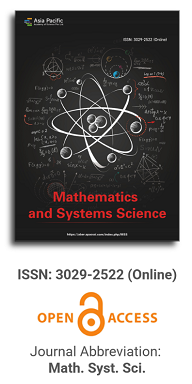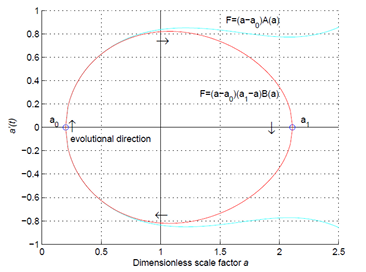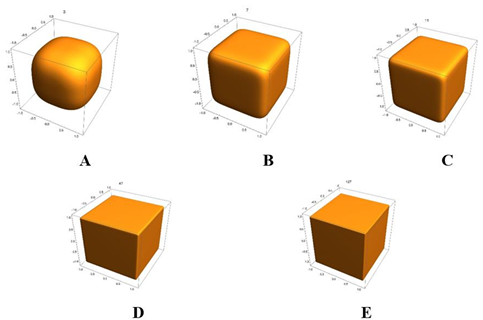


Fractal behavior accompanied by the complex-conjugated power-law exponents discovered in living systems: Analysis of the temporal evolution of impedance in silkworm cocoons
Vol 3, Issue 2, 2025
Download PDF
Abstract
In this paper, we continue using the theoretical model describing 3D-branching systems that is applied to describe the living system, such as the silkworm butterfly cocoons (Bombyx mori). The proposed fitting function that follows from the applied model allows us to describe completely with high accuracy (the fitting error is less than 0.1%) the whole stage of the temporal evolution of the silkworm cocoons in room conditions (during 13 days of the experiment the lowest temperature noted was 27 ℃ and the highest temperature was 29 ℃) and with relative humidity located in the interval [Hmin 54% £ H £ 76% Hmax] during 13 days (13 November 2023 to 25 November 2023) of the impedance measurements. The selection of this biological object is related to the fact that all possible conducting channels formed inside the given cocoon have 3D structures. Analysis of the measured impedance data shows that the measurements at the beginning of each day have a monotone character, while each measurement after the first measurement of each day has chaotic behavior. It means that during the night a cocoon “has a rest”. After this resting period, the applied voltage disturbs internal processes that are reflected in the behavior of the measured impedance. It has an oscillating character. These oscillations reflect the “regrouping” of conducting channels that take place inside the measured cocoon.
Keywords
References
- Nigmatullin R, Sarkar S, Biswas K. The Detection of Self-Similar/Branching Processes in Complex Biological Systems: Analysis of the Temporal Evolution of Impedance Measurements in Tulsi (Holy Basil) Leaves “Ocimumtenuiflorum.” IEEE/ACM Transactions on Computational Biology and Bioinformatics. 2022; 19(5): 3038-3047. doi: 10.1109/tcbb.2021.3107323
- Nigmatullin RR, Sarkar S, Biswas K. Detection of a fractal element with complex-conjugated power-law exponents in living systems: Analysis of the temporal evolution of impedance measurements in the unblown bud plumeria flower (frangipani plumeria). In: International workshop on Advanced Theory and Applications of Fractional Calculus. Springer; 2021. pp. 118–124.
- Chen F, Porter D, Vollrath F. Structure and physical properties of silkworm cocoons. Journal of The Royal Society Interface. 2012; 9(74): 2299-2308. doi: 10.1098/rsif.2011.0887
- Rahmathulla VK. Management of Climatic Factors for Successful Silkworm (Bombyx moriL.) Crop and Higher Silk Production: A Review. Psyche: A Journal of Entomology. 2012; 2012: 1-12. doi: 10.1155/2012/121234
- Ashraf H, Qamar A. Silkworm Bombyx mori as a model organism: A review. Physiological Entomology. 2023; 48(4): 107-121. doi: 10.1111/phen.12421
- Lü P, Pan Y, Yang Y, et al. Discovery of anti-viral molecules and their vital functions in Bombyx mori. Journal of Invertebrate Pathology. 2018; 154: 12-18. doi: 10.1016/j.jip.2018.02.012
- Marzoli F, Antonelli P, Saviane A, et al. Bombyx mori from a food safety perspective: A systematic review. Food Research International. 2022; 160: 111679. doi: 10.1016/j.foodres.2022.111679
- Montali A, Berini F, Saviane A, et al. A Bombyx mori Infection Model for Screening Antibiotics against Staphylococcus epidermidis. Insects. 2022; 13(8): 748. doi: 10.3390/insects13080748
- Abdelli N, Peng L, Keping C. Silkworm, Bombyx mori, as an alternative model organism in toxicological research. Environmental Science and Pollution Research. 2018; 25(35): 35048-35054. doi: 10.1007/s11356-018-3442-8
- Muhammad A, Qian Z, Li Y, et al. Enhanced bioaccumulation and toxicity of Fenpropathrin by polystyrene nano(micro)plastics in the model insect, silkworm (Bombyx mori). Journal of Nanobiotechnology. 2025; 23(1). doi: 10.1186/s12951-025-03120-8
- Tulachan B, Meena SK, Rai RK, et al. Electricity from the Silk Cocoon Membrane. Scientific Reports. 2014; 4(1). doi: 10.1038/srep05434
- Liu J, Shi L, Deng Y, et al. Silk sericin-based materials for biomedical applications. Biomaterials. 2022; 287: 121638. doi: 10.1016/j.biomaterials.2022.121638
- Leal‐Egaña A, Scheibel T. Silk‐based materials for biomedical applications. Biotechnology and Applied Biochemistry. 2010; 55(3): 155-167. doi: 10.1042/ba20090229
- Nigmatullin RR, Toboev VA, Lino P, et al. Reduced fractal model for quantitative analysis of averaged micromotions in mesoscale: Characterization of blow-like signals. Chaos, Solitons & Fractals. 2015; 76: 166-181. doi: 10.1016/j.chaos.2015.03.022
- Nigmatullin RR, Mehaute AL. Is there geometrical/physical meaning of the fractional integral with complex exponent? Journal of Non-Crystalline Solids. 2005; 351(33-36): 2888-2899. doi: 10.1016/j.jnoncrysol.2005.05.035
- El-Nabulsi RA. Modelling nematic liquid crystal in fractal dimensions. Medicine in Novel Technology and Devices. 2024; 24: 100334. doi: 10.1016/j.medntd.2024.100334
- El-Nabulsi RA. Fractal Pennes and Cattaneo–Vernotte bioheat equations from product-like fractal geometry and their implications on cells in the presence of tumour growth. Journal of The Royal Society Interface. 2021; 18(182): 20210564. doi: 10.1098/rsif.2021.0564
- Chen Y. Fractal Modeling and Fractal Dimension Description of Urban Morphology. Entropy. 2020; 22(9): 961. doi: 10.3390/e22090961
- Chen Y. Two Sets of Simple Formulae to Estimating Fractal Dimension of Irregular Boundaries. Mathematical Problems in Engineering. 2020; 2020: 1-15. doi: 10.1155/2020/7528703
- He L, Addison Z, Mele EJ, et al. Quadrupole topological photonic crystals. Nature Communications. 2020; 11(1). doi: 10.1038/s41467-020-16916-z
- Mittal S, Orre VV, Zhu G, et al. Photonic quadrupole topological phases. Nature Photonics. 2019; 13(10): 692-696. doi: 10.1038/s41566-019-0452-0
- Shimada H, Hikami S. Fractal Dimensions of Self-Avoiding Walks and Ising High-Temperature Graphs in 3D Conformal Bootstrap. Journal of Statistical Physics. 2016; 165(6): 1006-1035. doi: 10.1007/s10955-016-1658-x
- Mohsen M, Said LA, Madian AH, et al. Fractional-Order Bio-Impedance Modeling for Interdisciplinary Applications: A Review. IEEE Access. 2021; 9: 33158-33168. doi: 10.1109/access.2021.3059963
- Lopes AM, Machado JT. Modeling vegetable fractals by means of fractional-order equations. Journal of Vibration and Control. 2015; 22(8): 2100-2108. doi: 10.1177/1077546315581228
Supporting Agencies
Copyright (c) 2025 Author(s)
License URL: https://creativecommons.org/licenses/by/4.0/
Editor-in-Chief

Prof. Youssri Hassan Youssri
Cairo University, Egypt
Asia Pacific Academy of Science Pte. Ltd. (APACSCI) specializes in international journal publishing. APACSCI adopts the open access publishing model and provides an important communication bridge for academic groups whose interest fields include engineering, technology, medicine, computer, mathematics, agriculture and forestry, and environment.


.jpg)

.jpg)
